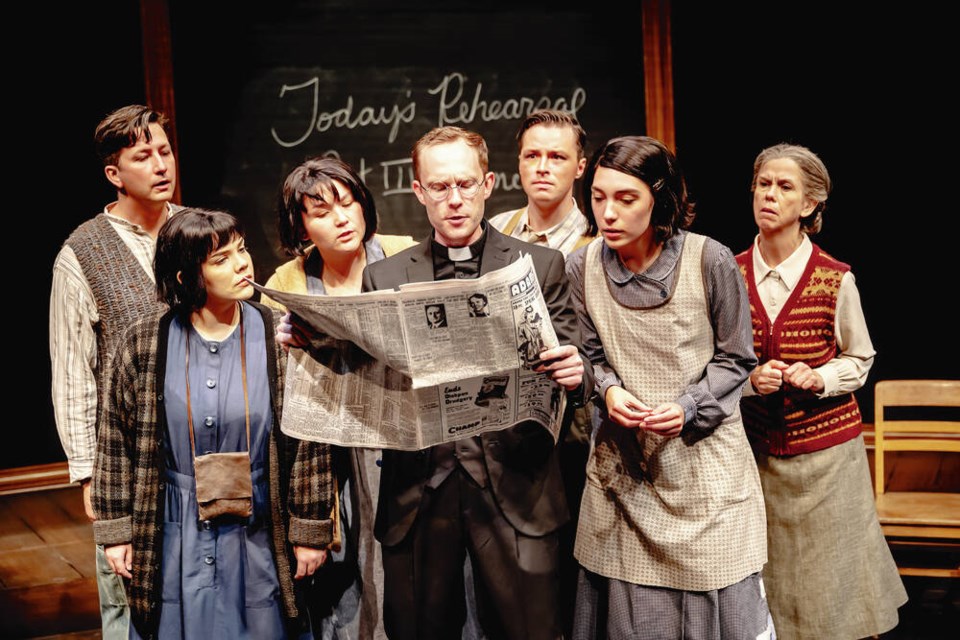1939
Where: The Belfry Theatre, 1291 Gladstone Ave.
When: Oct. 29-Nov. 24
Tickets :Pay What You Can (385-6815 or online at tickets.belfry.bc.ca)
A play commissioned by the Stratford Festival in Ontario is opening at The Belfry Theatre tonight, more than five years after the idea for the play about residential school survivors was conceived by Toronto playwrights Jani Lauzon and Kaitlyn Riordan.
But the emotional toll of bringing 1939 to the stage is still fresh for Lauzon, who is directing the production. “I think it’s a beautiful play, and we’ve had thousands of people watch it, and be thankful for it,” she said. “I’m confident in the art, but it does require a certain kind of sensitivity.”
The multi-faceted musician and playwright of Indigenous, French and Finish ancestry, was born in Kimberley, B.C., but lost her mother at an early age. She was raised by foster parents, in Cranbrook, B.C., and knew little about her ancestry while growing up. The writing of 1939, which runs through Nov. 24 at the Fernwood theatre, came about as she researched and learned more specifics about her upbringing, and how that pertains to her art.
1939 is about an English teacher at a residential school in Northern Ontario who preps her students for a production of the William Shakespeare play, All’s Well That Ends Well. King George VI, who is on his first Royal Tour of Canada in 1939, will be among the audience. The bigger story sits somewhat below the surface, however, and focuses on the strength of the five students — which Lauzon said are composites of people interviewed during the writing process — who use a range of means to cope with their circumstances.
The production was thrown a curveball Monday by The Walrus, a Toronto website and magazine, which published an investigative piece questioning Lauzon’s Indigenous ancestry and, by proxy, the accuracy of the play itself. The latter claim is disheartening, Lauzon said, as Indigenous elders, residential school survivors and spiritual and cultural advisors were consulted regularly throughout the development of 1939. One such person was Kettle and Stony Point First Nation elder Elizabeth (Liz) Stevens, who is the Elder-in-Residence at the Stratford Festival.
“The biggest challenge with the article was the point that the play is inaccurate and so therefore not worthy of being put on, because I am not Indigenous enough and therefore I must not know what I am talking about.”
Lauzon said her Indigenous ancestry is four or five generations deep, but the article, more than 4,000 words in length, goes to great lengths to question those claims. Lauzon (who identifies on her website as an artist of mixed settler and Indigenous ancestry) said stories pertaining to her family history were passed down to her through her father and grandmother, both of whom have died. She infused stories from both into the storylines of 1939.
It was an understandably difficult task, she said. “It took a while for me to get my father to talk about his experience at [Ker Maria, a convent in Alberta].” She added, “It’s not a monolithic experience. Each one of the people that I talked to, and that shared their stories, had very, very different experiences. You can never actually accurately represent all experiences in one piece of theatre.”
Lauzon and Riordan chose, “very specifically,” she said, five unique perspectives for the characters of the students. “All the personal experiences that happened, some [were] absolutely horrific, and some were quite joyous.”
There’s a sense of humour to the piece, which Lauzon felt was important. She was buoyed in her approach by Wikwemikong, Manitoulin Island elder Edna Manitowabi, who told her “to make it funnier.” That was an important endorsement, according to Lauzon.
“We were very, very aware that we were taking a risk in using humour. But [Manitowabi] said humour was the medicine for [residential school] students; it was part of their survival tactic. But it’s medicine for the audience, so they can actually engage with the moments of depth, and the emotional content in the play. It is a very difficult and very fine balance, in terms of too much humour is too much, and not enough is not enough. We did our best, I think, in terms of really, really trying to find what that balance was.”



